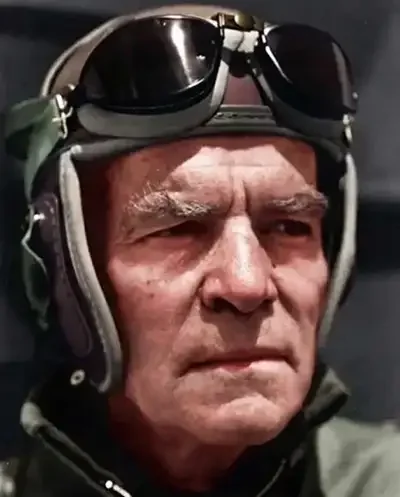- Military History
- Biographies
- Militarians Biographies
- Major General Adna Romanza Chaffee Jr.
Major General Adna Romanza Chaffee Jr.
The so called "Father" of the U.S. Armored Force for his role in developing the U.S. Army's tank forces
Chaffee was the only son of the remarkable Adna Chaffee Sr. who had joined the army as a private during the Civil War and by the end of his career would become chief of staff of the army with the rank of lieutenant general. The junior Chaffee steeped in the military and graduated from West Point in the upper hall of his 1906 class.
Assigned to the First Cavalry, he served in the so-called Army of Cuban Pacification (1906-07), then returned to the States to attend the Mounted Services School at Fort Riley, Kansas from 1907 to 1909. Chaffee excelled at horsemanship, not only creating and commanding a special mounted detachment for the Army War College (1910-11) but competing in the prestigious international horse show during the festivities for the coronation of King George V of Great Britain in 1911.
Chaffee was given the honor of attending Saumur, the French cavalry school, widely recognized as the finest military equestrian school in the world (from 1911 to 12). He returned to Fort Riley as an instructor at the Mounted Services School (1912-13) and then shipped out with the Seventh Cavalry in the Philippines (1914-15) returning in 1916 to West Point as senior cavalry instructor in the Tactical Department.
Promoted to captain, Chaffee was assigned in August 1917 as adjutant to the Eighty-First Division at Camp Jackson, South Carolina and briefly served as acting chief of staff for the division from December 1917 to February 1918 when it sailed for France and the Western Front of World War I. At Langres (France), Chaffee attended the General Staff College (March - May 1918) and later served there as an instructor. In August 1918 he was appointed assistant G-3 (operations officer) for the IV Corps and soon afterwards the G-3 of the Eighty-First Division and of VII Corps (August - October) during offensives at St. Michel (12-17th September 1918) and Meuse-Argonne (26th September to 11th November).
During the last days of the war, Chaffee served with the temporary rank of colonel and was G-3 for the III Corps. They decorated him with the Distinguished Service Medal and then remained in Europe with the III Corps as part of the army of occupation in the Rhineland.
Chaffee returned to the United States as an instructor at the Line and Staff School (later called the Command and General Staff School) at Fort Leavenworth in Kansas from July 1919 to May 1920. He received a promotion to major in 1920 after reverting to his permanent rank of captain in August. After brief service with the Third Cavalry during May to August 1920 he was reassigned as a G-2 (intelligence officer) of the IV Corps area in Atlanta from August 1920 - 21), and then as the G-3 of the First Cavalry Division at Fort Bliss in Texas where he served until July 1924.
After attending the Army War College from July 1924 to May 1925, Chaffee was assigned the command of a squadron of the Third Cavalry at Fort Myer in Virginia, a plum posting just outside Washington D.C. He served here until June 1927 when he was posted to the Operations and Training Division of the War Department General Staff. In this post, Chaffee, now a lieutenant colonel, helped to develop the army's mechanized forces.
In 1931, they assigned him to command the newly formed First Cavalry (Mechanized) Regiment at Fort Knox. Serving through February 1934 as the regimental commander and then as overall commander of the First Cavalry, Chaffee did much to establish, train, and organize the army's first armored unit. He was also instrumental in developing the basic doctrine of mechanized warfare.
From June 1934 to June 1938 Chaffee headed up the Budget and Legislative Planning Branch of the War Department General Staff and he used this position to fund increased mechanization. Returning to Fort Knox he again served as commander of the First Cavalry (Mechanized) (June to November 1938) and after being promoted to brigadier general on November 3 he was made commander of the Seventh Mechanized Brigade (First and Thirteenth Mechanized Cavalry Regiments).
With the United States perilously close to entering World War II, Chaffee directed the Seventh Brigade in large-scale maneuvers at Plattsburgh, New York (1939) and in Louisiana (summer of 1940). This practical experience allowed him to refine and further develop American doctrines of armor. The key concept Chaffee planned was the combination of armored, infantry and artillery operations - the integration of which would prove crucial in the coming war.
They made Chaffee commander of the Armored Force on the 10th of June 1940. This gave him responsibility for all infantry tank and mechanized cavalry units, with supporting artillery, motorized infantry and engineer units. He created the First and Second Armored Divisions and on the 2nd of October 1940; They promoted him to major general. Unfortunately, Chaffee's career was cut short by cancer at the height of his success. He died the summer before Pearl Harbor and thus the U.S. Army was deprived of one of its most valuable officers on the eve of the greatest conflict the nation had ever faced.
Major General Adna Romanza Chaffee Jr. - Quick Facts
- 7th Cavalry Brigade (United States)
- I Armored Corps (United States)
- Cuban Pacification - Second Occupation of Cuba (1906-1909)
- WWI (1914-1918)
- {{#owner}}
- {{#url}} {{#avatarSrc}}
{{name}} {{/url}} {{^url}} {{#avatar}} {{& avatar}} {{/avatar}} {{name}} {{/url}} - {{/owner}} {{#created}}
- {{created}} {{/created}}
























